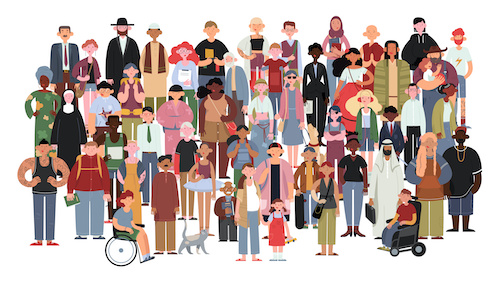It’s common, for instance, to hear a company leader note that they’ve made a diversity hire, and in this case, they are usually speaking to having hired a person of color. It is also commonplace to hear a parent speak to the fact that their child attends a very diverse school, and by this, they are often referring to their child attending a school that is racially and/or ethnically diverse. Last, but not least, another example would be hearing someone speak to the notion of their school or school system having a diversity issue, and often by it, they are meaning that their school or school system may be experiencing tensions, conflict, or challenges that are racially driven in some manner.
Is race diversity? Yes. However, diversity isn’t just about race. Diversity is a broad undertaking of the consideration of many different identities, representations, and differences, so it’s important to know that we have to name precisely and specifically what types of diversity we as individuals, we as schools, we as school systems, we as nonprofits, and we as education companies we are speaking of, focusing on, and centering. In no way will you ever be mindful of 50 million types of diversity as you move about your day teaching students, leading campuses, managing organizations, and leading systems, but the goal is that you understand that diversity encompasses race but is also deeper than just race alone.
Diversity is and speaks to the wide variety of forms of representation and truly the importance of ensuring that you carry consideration for multiple perspectives, viewpoints, lived experiences, backgrounds, voices, and needs in what you say and do in your work each day. When you push for diversity, push that race and racial/ethnic diversity be centered in what you’re doing, and also push that within racial diversification, you’re also mindful of other aspects of diversity our students, families, colleagues, and stakeholders embody, so that we not embrace one aspect of who they are, but we make room for other aspects of our students’ and even adults’ identities as well.
Engage in inner work alongside your school initiatives
Whatever you’re doing, please look in the mirror simultaneously–and honestly first–because it is easier to analyze and critique the actions of institutions and systems, which should be held accountable, but it must be met with the commitment to also critically examine oneself just the same. In order to make true, enduring, and the most meaningful change, your journey of centering and advancing diversity, equity, and inclusion must involve committing to the do the work at the individual level (i.e. intrapersonal work or often what would be considered the “inner work”); the institutional level (i.e. which encompasses both your departmental or team level work, as well as organization-wide efforts); and advocating for systemic change (i.e. macro level changes across organizations and systems) as well.
It’s quite easy to adopt a purely technical lens of diversity, equity, and inclusion work as a leader. This might look like falling into the trap of believing that the adoption of a checklist or framework along with your team’s fidelity and consistency in its use will drive your school or district to become a more inclusive environment, an embrace of diversity in its many forms, and equitable outcomes for children. This might also look like falling into the trap of believing that a singular diversity, equity, and inclusion training or a series alone will address your need to center and advance DEI within your school, school system, or education adjacent organization. Am I saying that checklists aren’t effective? No. Am I saying that trainings are ineffective as a method of centering and advancing diversity, equity, and inclusion? No again. Tools have their place and are important. In fact, as leaders, tools often help us to institutionalize practices within schools, districts, and education-adjacent organizations as a whole, but there is no checklist, framework, or tool that can replace the inner work needed for the journey.
The absolute best thing you can do as an educator is embrace the fact that the work of DEI must begin with you. You cannot advance an agenda that you are not willing to first examine at the intrapersonal level, which means that this work requires the courage to explore your own lens, schema, world views, socialization, bias, privilege, and shortcomings. In other words, you can be a well-meaning educator and still not effectively center DEI. The question isn’t what your intentions are. The question is whether you are willing to examine how what you house inside – your mindsets, your beliefs, and your blind spots, for instance – directly or indirectly impacts others, namely children, every day.
Related:
3 ways educators can embrace and enable inclusive programming
How to ensure digital equity in online testing
- Career and technical education needs a mental health revolution - June 16, 2023
- With Critical Race Theory spurring debate, is there hope for diversity in schools? - June 16, 2023
- Is AI the future of education? - June 15, 2023

